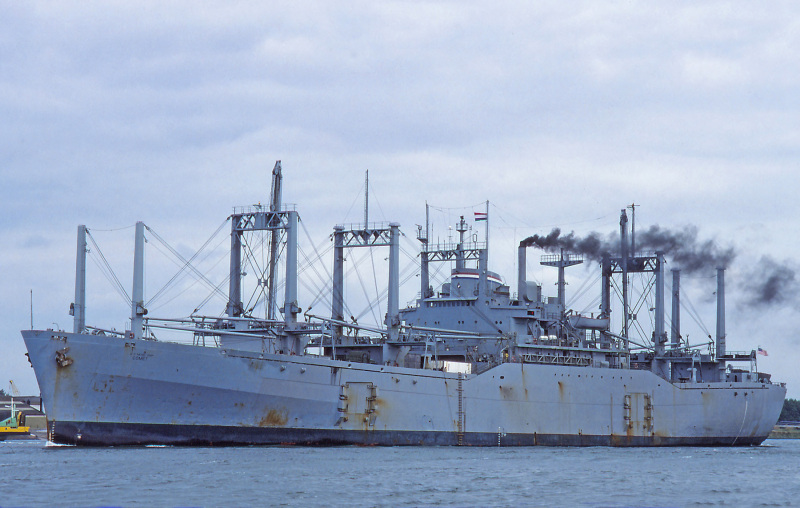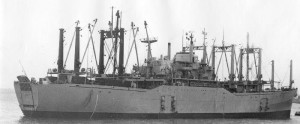USNS Comet set to be removed from ‘Ghost Fleet’ Wednesday
The USNS Comet, a former Navy vehicle landing ship affectionately called by its crew “The Mother of All Ro/Ros,” will be pulled out of the Maritime Administration’s Reserve Fleet in Suisun Bay on Wednesday and prepared for its final journey to Texas, to be broken apart and recycled.The Comet is the last of its kind, according to information provided by the Maritime Administration.
Later in the ship’s career, Baltimore Sun reporter John H. Gormley Jr. described the Comet as “one of those quiet, unassuming pioneers bound to live out their old age in obscurity, despite youthful accomplishments.”
Compared to other ships that had served in the Persian Gulf, he wrote, the Comet “looked to the casual observer like just another pale gray military cargo ship. The only clue to her special status in the history of the maritime industry was stenciled in unobtrusive black letters under the wings of the ship’s bridge: ‘The Mother of All Ro/Ros.’”
The ship is considered the first oceangoing “Roll On-Roll Off” vessel for loading and unloading rolling cargo, such as cars and trucks. That led to the nickname.
The military assigned it the designations T-AK-269, T-LSV-7 and finally T-AKR-7. It is the fourth U.S. Naval vessel to be named “Comet.”
It is the first deep-draft, ocean-going cargo vessel built for self-loading. The ship has a stern-loading ramp as well as four side-loading ports that allow vehicles to load under their own power. It is equipped with a series of internal ramps, kingposts and booms on the main deck that let vehicles either load and unload under their own power, or be towed into the holds and through deck hatches.
The Comet was built of riveted and welded steel by Sun Shipbuilding and Dry Dock Company of Chester, Pa., in 1957. It is powered by two boilers that generate steam to drive geared turbines that, in turn, propel twin screws. Its only superstructure is a single deckhouse, at approximately midship. It operated as part of the common user fleet of the Military Sea Transportation Service (MSTS) and Military Sealift Command (MSC.)
The keel was laid May 15, 1956 and was launched July 31, 1957. The Comet was delivered Jan. 24, 1958. Bertha Sabin, wife of Vice Admiral Lorenzo S. Sabin Jr., U.S. Atlantic Fleet amphibious force commander, christened the ship, which cost $11.12 million to build.
On its first voyage in 1958, from Philadelphia to St. Nazaire, France, the Comet carried 399 vehicles that had been loaded in 12 hours. Previously, the operation would have taken three days. After delivering the cargo to Bremerhaven, Germany, the Comet picked up passenger vehicles it delivered to the Brooklyn Army Terminal in New York Harbor.
It then traveled to Virginia to load 300 2 1/2-ton trucks for France and Germany. The ship also carried Redstone missiles to American bases in Europe.Among its more notable assignments, the Comet was among the ships deployed during the 1958 Lebanon crisis, a situation that arose amid political and religious tensions in the Middle East at a time when some countries, including Egypt, changed their forms of government and rejected former ties with Western countries.
Camille Chamoun, the pro-West president of Lebanon, asked for American intervention amid the region’s unrest. Forces from both the U.S. and Lebanon occupied both the port and the international airport of Beirut, and when tensions eased, the U.S. withdrew.
Impressed by the Comet’s performance, then-Defense Secretary Robert McNamara sought construction of five Comet-class “Ro/Ro” ships in a project that would have started in 1963. The program was only partially completed, stymied by private-industry contractors. But the Comet’s capabilities still were able to change how defense sealifts operated, according to multiple reports.
The Comet initially was placed in service as a Cargo Ship, with the designation T-AK-269. In 1963, it was designated as a Vehicle Landing Ship and given the identity T-LSV-7, and as a Vehicle Cargo Ship-Roll On-Roll Off Ship and given the number AKR-7 in 1969.
During those years, the ship sailed the Pacific, working at least five years on the 20- to 22-day circuit that links Okinawa, Vietnam and Thailand, landing vehicles in absence of piers or wharfs.
Once military officials were convinced it could do the job, the Comet was instrumental in launcing Army LARC-V amphibious vehicles directly into the water from the ship’s stern ramp into Vietnam war zones.
Once the U.S. ended its involvement in Vietnam, the Comet returned to the Atlantic to support American activities in Western Europe. It was reassigned from MSC to the Maritime Academy Ready Reserve Force (RRF) in 1984 and was among the 78 RFF ships activated to participate in Operation Desert Shield and Desert Storm.
Reactivated in 2003, the Comet ferried a dozen U.S. Marine engineers and equipment from San Diego to Kuwait in preparation for the invasion of Iraq. After the Comet returned to California, the ship was placed in a reduced operating status in Alameda. It participated in multiple RRF exercises. and later was downgraded and removed from RRF in 2006.
During its active career, the ship was awarded the Navy Battle “E” Ribbon, the National Defense Service Medal, the Vietnam Service Medal, the Southwest Asia Service Medal and the Republic of Vietnam Campaign medal.
Once the Comet was moored among the Suisun Bay Reserve Fleet, the Maritime Administration made it available until July 7, 2014, to any organization. The National Park Service completed a Historic American Engineering Record survey for the Comet, and a 360-degree photographic tour, including 43 panoramic images of the ship, also was made.
However, without those offers, the ship remained off the Benicia coast as a surplus vessel that later was designated as obsolete, to be broken apart and recycled.
As part of a federal program instituted in 2009 to remove the aging surplus vessels in the Suisun Bay Reserve Fleet, the Comet will be pulled from its mooring about 11 a.m. Wednesday, depending on weather conditions, according to the statement issued by the Maritime Administration.
The ship will be prepared for towing south and through the Panama Canal to All Star Metals in Brownsville, Texas, where it will be broken apart and recycled.








I saw her for the last time this past Saturday. Her sister ship the meteor will be next. An end of an era. Both still in great shape but no home.